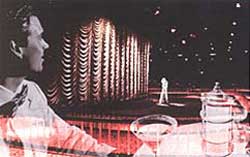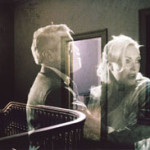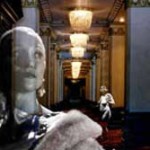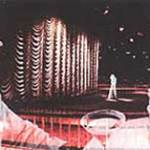And his finished work does, after all, fit a ready-made notion of fiction and decay with considerable success. He began with time-lapse shots in beautiful color 35mm of Hollywood’s Ambassador Hotel, which has been closed and fortuitously evading demolition since 1989. Built in 1920, it was a swanky stomping ground of powerful tycoons, politicos, and movie icons until 1968 when it became the location of Robert Kennedy’s assassination. In a way, it’s easy to recognize a decay of fiction in the hotel itself, and O’Neill’s use time-lapse photography, forming shapes with shadows and light slipping across now soggy carpets and empty swimming pools, practically allows us to see the paint peeling off the walls (no pun intended). Each shot, inside and outside the hotel, allows us to see the entire repertoire of settings that the building offered over 1,000 films.
After O’Neill finished the time-lapse segment of his production, he began shooting actors using black and white film in quintessentially Noir-esque sequences written by himself. He then optically printed these sequences onto the time-lapse shots of the hotel, producing translucent images resembling ghosts à la George Lucas’ holograms in his Star Wars films. These scenes from familiar Hollywood plots actually draw us into the film and into the space of the hotel. The camera angles are all kept consistent with the horizon line and a typical Noir-like film score overlays even the most dissonant of these sequences helping to glue together an apparent narrative or familiarity for the majority of film. The sequences seem to be episodes of any typical evening at the Ambassador but they are only remnants, pieces of a decayed past and a dead Hollywood genre that O’Neill uses to generate a liminal space between fact and fiction.
We are brought out of this space during many surreal interludes of dancing nudes on blackened stages. Some of these characters actually invade the hotel as the film progresses, adding a horrific dimension appropriate to the site of RFK’s assassination. Live action actors also enter the film, actually wrenching you from the cinematic artifice—which O’Neill wants to draw our attention to and so allow a deconstruction of—much more abruptly than his surreal imagery. When a woman in full flesh walks down a hotel hallway, 45 minutes into the film, she appears to be invading the movie set, a real, live person exploring the crumbling remains of the Ambassador Hotel, trespassing both on condemned property and on the illusion of the “movie” O’Neill created.
O’Neill is indeed interested in the surreal, as he admitted when introducing the film, and perhaps his film’s rather coherent cohesion drove him, in the end, to create the nightmarish mêlée that the film unfortunately ‘decays’ to in the end. The beings and images that haunt the film only in brief interludes finally take it over in a gala of technical virtuoso, impressively all done with actual film (not digitally), and away from its historical and medium conscious commentary, but they cannot rob the film of its fundamental successes.
----
Links:
Tracing the Decay of Fiction / DVD
Pat O'Neill's "Decay of Fiction" was screened at the Museum of Fine Arts on February 24, 2004.
*Quoted from: http://www.athensfest.org/2003/artists.php?cid=2003_pat_oneill
Christian Holland is a regular contributor to Big, Red and Shiny.






